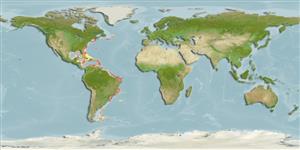Common names from other countries
Myxini (peixes-bruxa) (hagfishes) >
Myxiniformes (Hagfishes) >
Myxinidae (Hagfishes) > Eptatretinae
Etymology: Eptatretus: hepta (Gr.), seven; tretos (Gr.), perforated (i.e., with holes), referring to seven gill apertures on what would later be described as Homea banksii (=E. cirrhatus) [range within genus is 6-14 pairs of gill apertures]. (See ETYFish); multidens: multus (L.), many; dens (L.), tooth, referring to high tooth count (three fused teeth in each row). (See ETYFish).
More on authors: Fernholm & Hubbs.
Environment: milieu / climate zone / depth range / distribution range
Ecologia
marinhas batidemersal; não migratória; intervalo de profundidade 239 - 770 m (Ref. 31276). Deep-water
Western Atlantic: Caribbean Sea and off French Guiana (Ref. 36999), including northeastern Brazil (Ref. 52140).
Tamanho / Peso / Idade
Maturity: Lm ? range ? - ? cm
Max length : 81.5 cm TL macho/indeterminado; (Ref. 52140)
Descrição suscinta
Chaves de identificação | Morfologia | Morfometria
Diagnosis: Gill pouches 6 pairs. Fused cusps 3 in both anterior and posterior rows of teeth; total cusps 50-58. No middorsal light stripe (Ref. 52140). Slime pores: prebranchial 14-16; branchial 5-7; trunk 52-55; tail 15; total 87-93 (Ref. 41105).
Minimum depth given from Ref. 52140.
Ciclo de vida ou comportamento de acasalamento
Maturities | Reprodução | Spawnings | Egg(s) | Fecundities | Larvas
Copulatory organ absent. The gonads of hagfishes are situated in the peritoneal cavity. The ovary is found in the anterior portion of the gonad, and the testis is found in the posterior part. The animal becomes female if the cranial part of the gonad develops or male if the caudal part undergoes differentiation. If none develops, then the animal becomes sterile. If both anterior and posterior parts develop, then the animal becomes a functional hermaphrodite. However, hermaphroditism being characterised as functional needs to be validated by more reproduction studies (Ref. 51361 ).
Fernholm, B., 1998. Hagfish systematics. p. 33-44. In J.M. Jørgensen, J.P. Lomholt, R.E. Weber and H. Malte (eds.) The biology of hagfishes. Chapman & Hall, London. 578 p. (Ref. 31276)
Status na Lista Vermelha da UICN (Ref. 130435)
CITES (Ref. 128078)
Not Evaluated
Ameaça para os humanos
Harmless
Uso pelos humanos
Ferramentas
Relatórios especiais
Baixar XML
Fontes da internet
Estimates based on models
Preferred temperature (Ref.
115969): 8.6 - 15.5, mean 11.5 (based on 79 cells).
Índice de diversidade filogenética (Ref.
82804): PD
50 = 0.5000 [Uniqueness, from 0.5 = low to 2.0 = high].
Bayesian length-weight: a=0.00204 (0.00092 - 0.00452), b=2.93 (2.73 - 3.13), in cm Total Length, based on LWR estimates for this (Sub)family-body shape (Ref.
93245).
Nível Trófico (Ref.
69278): 4.3 ±0.7 se; based on size and trophs of closest relatives
Resiliência (Ref.
120179): Baixo, tempo mínimo de duplicação da população 4,5 - 14 anos (Fec assumed to be <100).
Fishing Vulnerability (Ref.
59153): Moderate to high vulnerability (53 of 100).
